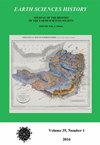记录事实:亨利·德拉贝什的地图是数据存储库
IF 0.6
4区 哲学
Q4 GEOSCIENCES, MULTIDISCIPLINARY
引用次数: 0
摘要
年轻时,亨利·托马斯·德拉贝切(1796-1855)参与了精英绅士社会的地质学研究。在英国内外的实地考察中,他考察了自然景观,并用叙事和插图记录了自己的观察结果。德拉贝切的地质图的起源可以追溯到1821年,当时他绘制了从圣瓦斯特到费坎普的法国沿海地图;1822年,他使用最近出版的军械地图(1:63360)绘制了威尔士彭布罗克郡南部的地图。对德拉贝切来说,最重要的是以图形形式准确记录事实观测结果,以便这些地图能够代表未来有用的数据。De la Beche继续在牙买加(1824年)和德文郡的托尔湾和巴贝科姆湾(1827年)绘制地图。1832年,在绘制德文郡地图时,德拉贝切的个人财务状况恶化。他成功地向政府请愿,要求继续他的地图项目,并提议他完成的地图将具有国家实用性。在完成德文郡地图后,德拉贝切利用该项目继续绘制该国其他地区的地图。他成为最终发展成为英国地质调查局的第一任局长。在这个位置上,De la Beche影响了绘图技术,同时坚持结果的一致性。几个人在德拉贝切手下学习了地质测量,并将他的方法带到了其他国家。由于De la Beche有选择地记录了他认为重要的观测地质,他的地质图是在其建造过程中记录的观测结果的图形数据库。他的测量技术也有着持久的影响。本文章由计算机程序翻译,如有差异,请以英文原文为准。
RECORDING THE FACTS: HENRY DE LA BECHE’S MAPS AS DATA REPOSITORIES
As a young man, Henry Thomas De la Beche (1796–1855) participated in geology within elite gentlemanly societies. On field excursions—within England and beyond—he examined the natural landscape and recorded his observations in both narratives and illustrations. The origin of De la Beche’s geologic maps can be traced to 1821, when he mapped coastal France from St. Vaast to Fecamp; in 1822 he mapped south Pembrokeshire, Wales, using the recently published Ordnance maps (1:63,360). Of utmost importance to De la Beche was an accurate recording of factual observations in graphic form so that the maps would represent useful data in the future. De la Beche continued mapping in Jamaica (1824) and Devon’s Tor and Babbacombe bays (1827). In 1832, while mapping Devonshire, De la Beche’s personal finances worsened. He successfully petitioned the government to continue his mapping projects, proposing that his completed maps would be of national practical utility. Following the completed Devonshire maps, De la Beche leveraged the project to continue mapping other parts of the country. He became the first director of what would eventually develop into the British Geological Survey. In this position, De la Beche influenced mapping techniques while insisting upon consistency of results. Several men learned geological surveying under De la Beche and brought his methods to other countries. Since De la Beche selectively documented the geology he deemed important to observe, his geological maps serve as graphic data repositories of observations recorded during their construction. His surveying techniques also have enduring influence.
求助全文
通过发布文献求助,成功后即可免费获取论文全文。
去求助
来源期刊

Earth Sciences History
GEOSCIENCES, MULTIDISCIPLINARY-HISTORY & PHILOSOPHY OF SCIENCE
CiteScore
1.00
自引率
0.00%
发文量
1
审稿时长
>12 weeks
期刊介绍:
Earth Sciences History promotes and publishes historical work on all areas of the earth sciences – including geology, geography, geophysics, oceanography, paleontology, meteorology, and climatology.
The journal honors and encourages a variety of approaches to historical study: biography, history of ideas, social history, and histories of institutions, organizations, and techniques.
Articles are peer reviewed.
 求助内容:
求助内容: 应助结果提醒方式:
应助结果提醒方式:


